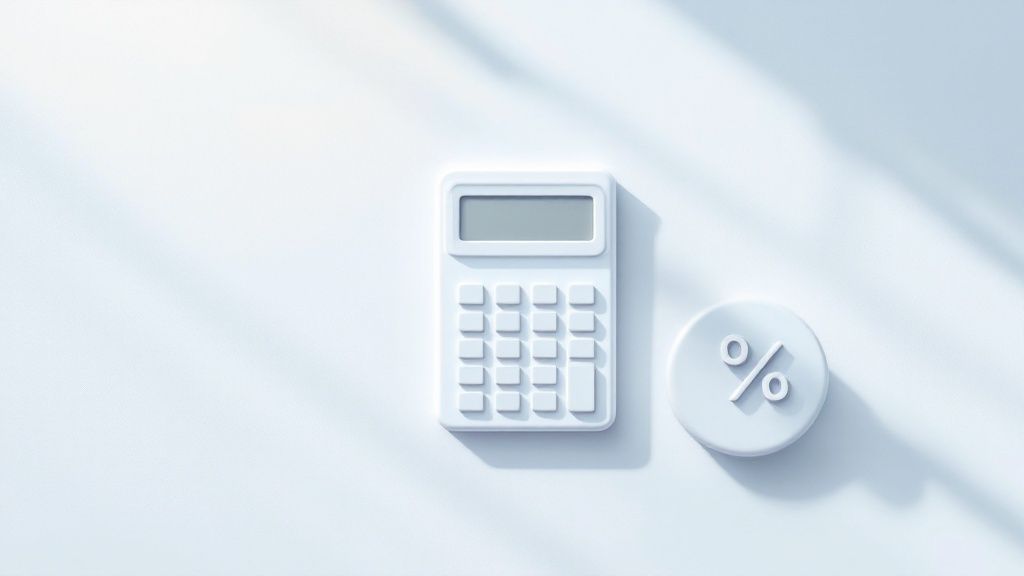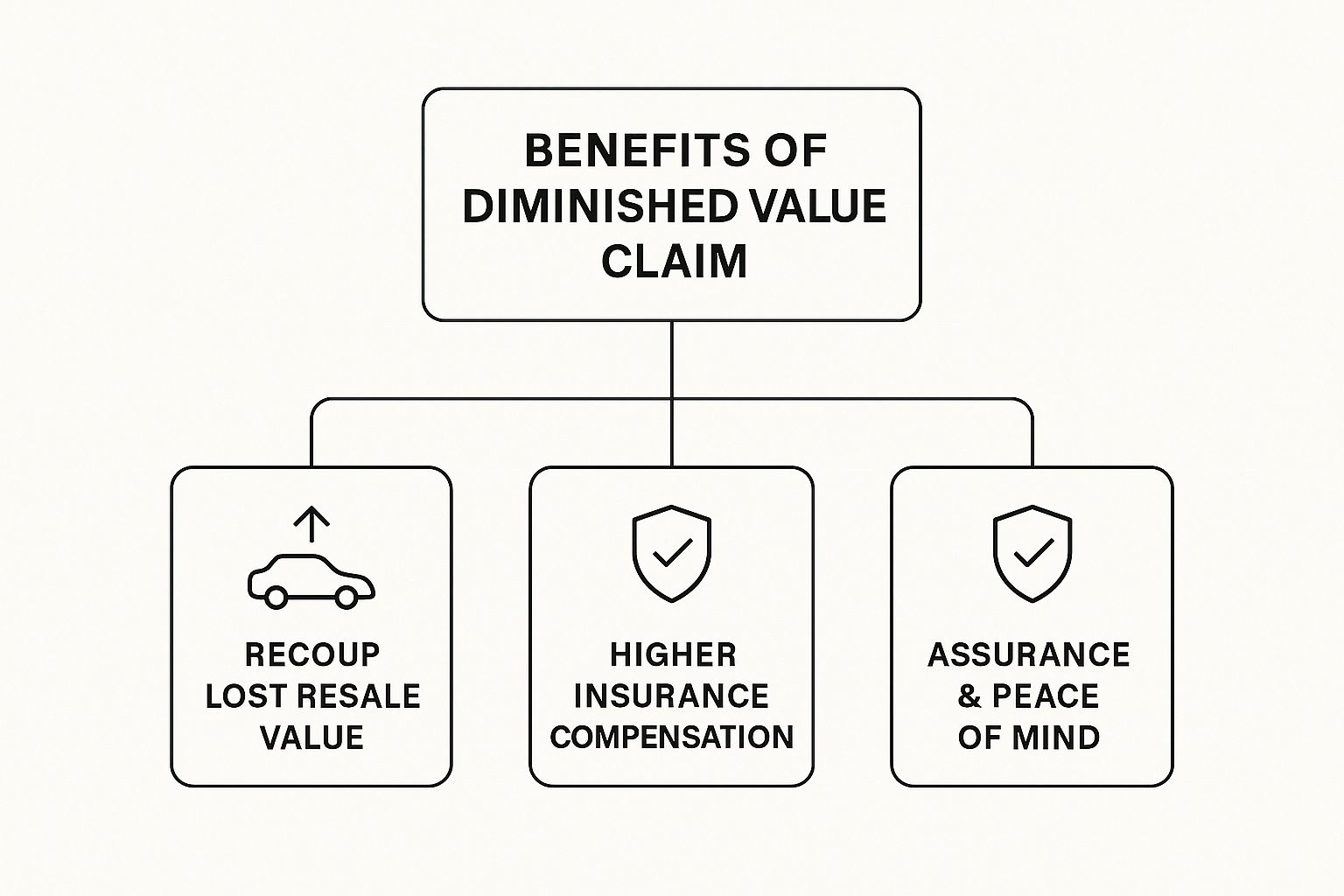When your car gets into an accident that isn't your fault, the at-fault driver's insurance pays to fix it. That's great, but what about the hit to your car's resale value? A diminished value claim is how you get compensated for that loss—the money your car is no longer worth simply because it now has an accident history.
Even if the repairs are absolutely perfect, a car that's been in a wreck is worth less than the exact same car with a clean record. This claim is your tool for recovering that lost value from the at-fault party's insurance company.
Understanding the True Cost of an Accident

Let's put it in real-world terms. Imagine you're in the market for a used SUV. You find two identical models—same year, same mileage, same features. One has a clean vehicle history report, but the other was in a collision a year ago. Which one would you buy?
If you're like most people, you'd go for the one with no accident history. Or, at the very least, you’d expect a hefty discount on the one that was in a wreck. That "hefty discount" is exactly what diminished value is.
This drop in market value is purely due to the stigma of an accident. It doesn't matter if the best body shop in the city made the car look brand new; its value is permanently dented. A diminished value claim is the formal process for getting that lost money back in your pocket.
The Three Types of Diminished Value
Diminished value isn't just one single concept; it actually breaks down into three distinct categories. Understanding them helps clarify exactly what you're claiming and why.
Here's a quick summary of the different types of diminished value you might encounter.
| The Three Types of Diminished Value |
| :— | :— | :— |
| Type of Diminished Value | What It Means | Example |
| Inherent Diminished Value | The automatic, unavoidable loss in value just because the vehicle has an accident on its record. This assumes excellent repairs were done. | Your perfectly repaired Honda CR-V is now worth $2,000 less than an identical one with a clean history. |
| Repair-Related Diminished Value| An additional loss in value because the repairs were subpar. This is on top of the inherent loss. | The new paint doesn't quite match the factory color, or the new fender isn't aligned properly. |
| Immediate Diminished Value | The difference in the car’s value right after the crash but before any repairs have been made. | This is the value of your car in its wrecked, undrivable state. It's less common for claims. |
While all three exist, inherent diminished value is the focus of nearly every claim. This is the value that was lost through no fault of your own, and it's the amount you're trying to recover.
The bottom line is this: You shouldn't have to suffer a financial loss because someone else was negligent. A diminished value claim is about making you financially whole again after an accident.
And the stakes can be quite high. While every situation is different, Kelley Blue Book suggests a car’s value can plummet by as much as 30% simply because of an accident history. If you want to dive deeper, you can explore more insights about claim statistics to see what you could be leaving on the table. Successfully recovering this loss is a key part of a fair and complete insurance settlement.
How Insurers Calculate Your Claim
Ever wonder how an insurance adjuster comes up with a number for your car's lost value? It’s not a guess. They lean on rigid, standardized formulas to arrive at a settlement figure, and knowing how they work is the key to understanding why their first offer is almost always too low.
One of the most common tools in their playbook is a formula called “17(c).” It came out of a Georgia court case, and while it's not the law everywhere, insurers love it because it’s predictable and, frankly, it saves them money.
This cookie-cutter approach feels completely disconnected from what your car is actually worth on the open market now that it has an accident history.
The Problem with Formulas Like 17(c)
The 17(c) formula, and others built like it, is basically a three-step process designed to shrink your payout. It systematically chips away at your car's value using caps and multipliers.
Here’s a quick look at how they whittle down the number:
- Step 1: The 10% Cap. First, they take your car's pre-accident value (from a guide like NADA or KBB) and immediately cap the maximum possible diminished value at 10%. Right off the bat, your claim has a ceiling, no matter how bad the wreck was.
- Step 2: The Damage Multiplier. Next, they multiply that capped amount by a "damage modifier," which is just a decimal between 0 and 1. A few scratches might get a 0.25, while major frame damage might get a 1.0. This slashes the number again.
- Step 3: The Mileage Multiplier. Finally, they hit it with a mileage multiplier. The more miles on your car, the more they deduct. This final reduction often takes a significant bite out of what's left of your claim.
This systematic process almost guarantees an offer that doesn't come close to reflecting how real buyers react to a car with a documented accident history.
A rigid formula can never fully capture the nuances of the local used car market, model popularity, or the specific stigma attached to structural repairs. It's a system designed for the insurer's efficiency, not for your fair compensation.
Let's look at a real-world example. A Hyundai Tucson SEL worth between $26,000 and $28,600 had over $2,000 in repairs. Using a formula like this, its diminished value might be calculated somewhere between $650 and $715. But the insurance company's initial offer? Just $400. This is a perfect illustration of how these formulas generate lowball numbers. You can learn more about valuation trends and the future of diminished value claims on AppraisalEngine.com.
Since their math is stacked against you, just accepting the insurer's figure is a mistake. You can get a ballpark estimate of your potential claim by using a diminished value claim calculator, but to make a formal demand, you need more firepower. A professional, USPAP-compliant appraisal from an independent expert is your best weapon to fight their formula with hard, market-based facts.
How Market Conditions Affect Your Claim

Insurance companies love their rigid formulas. They treat your car’s value like a fixed number they can just plug into a spreadsheet. But out here in the real world, a vehicle’s worth is a moving target, constantly swayed by the shifting tides of the used car market.
Getting a handle on these forces is the key to understanding why a one-size-fits-all calculation so often misses the mark on a diminished value claim. Think of your vehicle less as a static object and more like an asset whose value fluctuates daily, just like stocks or real estate.
Supply and Demand Dynamics
At its core, it all comes down to simple supply and demand. When used cars are hot commodities and the supply is tight—something we’ve seen a lot in recent years—prices naturally surge. In a seller's market like that, the financial sting from an accident history might be a little less severe simply because buyers have fewer cars to choose from.
Now, flip that scenario. When the market is flooded with cars just like yours, buyers get to be incredibly picky. That accident on your vehicle's history report suddenly becomes a massive red flag, giving them all the leverage they need to demand a steep discount. In a saturated market, your diminished value loss is going to be a much bigger deal.
Even with flawless repairs, a car's value drops after a wreck, and that loss is directly tied to the economy. Local car prices, seasonal buying habits, and the overall inventory of vehicles play a huge part in determining just how much value was lost.
Regional and Seasonal Influences
Where you live and even the time of year can have a surprisingly big impact on your car's value and, by extension, your claim.
Here’s what I mean:
- Regional Preferences: A 4×4 truck is a hot ticket in a snowy mountain town, but it’s just another vehicle in a sunny, flat city. The diminished value would be calculated very differently in each place because the local demand is completely different.
- Seasonal Demand: Convertible prices always seem to jump as summer gets closer, right? Meanwhile, minivan and SUV values often get a little boost before the new school year starts. The timing of an accident can absolutely affect the perceived financial loss.
A diminished value claim isn't just about the damage to the car; it's about the damage to the car's value within its specific market. An insurer's formula can't see that. It's stuck on pre-set percentages and generic multipliers.
To really see why your car isn't worth what it used to be, you have to look at the bigger picture and understand how past incidents can affect a vehicle's market value. This is exactly why a professional, market-based appraisal is the only way to prove the true financial hit you’ve taken.
Understanding State Laws and Your Rights
Filing a diminished value claim often feels like you're trying to navigate a maze where the walls move every time you cross a state line. The success of your claim really boils down to the specific laws in your state, so getting a handle on your rights is the first—and most important—step.
The biggest legal hurdle to clear is understanding the difference between a third-party claim and a first-party claim. It's actually pretty simple when you break it down:
- Third-Party Claim: You file this against the insurance company of the driver who was at fault. Their client caused the damage and the resulting financial loss, so their policy is on the hook to make you whole again.
- First-Party Claim: This is when you try to file a claim against your own insurance policy. For diminished value, this is a much harder path and rarely an option.
This is all about fighting for the compensation you're rightfully owed after an accident that wasn't your fault.

As you can see, the goal is to recoup that lost market value and make sure you’re not left out of pocket simply because someone else was negligent.
Where You Live Changes Everything
Here’s the good news. Pretty much every single state allows you to file a third-party diminished value claim. If another driver hits your car, the law is on your side, and you have the right to demand compensation for your car's lost value from their insurance company.
First-party claims, on the other hand, are a different story. Most auto insurance policies are written with specific exclusions that prevent you from claiming diminished value from your own insurer. A few states have carved out exceptions—Georgia is the most well-known—but for most people, this route is a dead end.
To see exactly where you stand, it's worth digging into the specific https://totallossnw.com/diminished-value-laws/ for your area.
The bottom line? Knowing the difference between these claim types is critical. For the vast majority of drivers, the road to getting paid for diminished value goes directly through the at-fault driver's insurance company.
Diminished Value Claim Rules in Key States
To give you a clearer picture, here’s a quick look at how some key states handle these claims. Notice how filing against the at-fault driver's insurance is almost always allowed, while claiming from your own policy is usually a no-go.
| State | Third-Party Claim (At-Fault Driver's Insurance) | First-Party Claim (Your Own Insurance) | Notes |
|---|---|---|---|
| California | Yes | No | You can claim DV against the at-fault party. |
| Texas | Yes | No | Texas law supports third-party claims. |
| Florida | Yes | No | Florida courts recognize third-party DV claims. |
| Georgia | Yes | Yes | Georgia is a rare exception where you can file first-party claims. |
| New York | Yes | No | New York allows you to pursue the at-fault driver's insurer. |
This table isn't exhaustive, but it highlights the pattern you'll see across the country. Always confirm the rules for your specific state.
Don't Let the Clock Run Out
There's one more piece to this legal puzzle you absolutely cannot ignore: the statute of limitations. This is a hard deadline set by your state for filing a lawsuit over property damage.
If you and the insurance company can't agree on a fair settlement, your only remaining option is to take them to court. But you have to do it before this legal window slams shut. These deadlines can be surprisingly different, ranging from just two years in a state like Texas to four years in Florida.
Miss that deadline, and you lose your right to recover a dime, no matter how solid your case is. If you feel an insurer is dragging its feet or lowballing your offer, you might be dealing with bad faith insurance practices. Be proactive—confirm your state's deadline and start the claim process right after your vehicle's repairs are finished.
How to Build a Winning Claim Step by Step

Successfully filing a diminished value claim isn’t about luck; it’s about a methodical approach. You have to shift from being the victim of an accident to being a prepared advocate for your own financial recovery. That means gathering the right proof and presenting it in a way the insurance company simply can't brush aside.
Think of it like building a court case. Every piece of evidence you collect strengthens your position. With a clear plan, you can confidently go after the full compensation you’re owed.
Step 1: Assemble Your Essential Documents
Before you even pick up the phone to call an adjuster, your first move is to gather all the relevant paperwork. This documentation is the bedrock of your claim, proving the facts of the accident, the severity of the damage, and the extent of the repairs.
Your objective is to create an undeniable paper trail that tells the complete story. Start by collecting these key items:
- The Police Report: This is the official, unbiased narrative of the accident. It’s absolutely critical for establishing who was at fault.
- Repair Invoices: Make sure you have the complete, itemized bill from the body shop. This document breaks down every part replaced and every hour of labor, painting a clear picture of the damage.
- Photographs: Gather any photos you have from before and after the repairs. Visual evidence of crumpled metal is incredibly persuasive.
- Vehicle Title: You’ll need to provide proof of ownership to file any claim.
Step 2: Get an Independent Appraisal
This is, without a doubt, the most important step in the entire process. The insurance company will use its own internal formulas to calculate your loss, and—no surprise—this almost always leads to a lowball offer. To counter their numbers, you need a qualified expert in your corner.
A professional, independent appraiser will generate a detailed report calculating your car's actual loss in market value. This isn't just a guess; it's a thorough analysis based on local market data, recent sales of comparable vehicles, and the specific stigma attached to your car's accident history. To see what goes into this critical document, you can learn more about the components of a professional diminished value report.
A free online calculator won't cut it for an official claim. For an insurer to take you seriously, your claim must be backed by a certified, USPAP-compliant appraisal from an independent expert. This report is your single most powerful negotiation tool.
Step 3: Submit a Formal Demand Letter
With your appraisal in hand and your documents organized, it's time to formally present your claim. Instead of getting tangled up in frustrating phone calls with an adjuster, you should submit a professional Demand Letter.
This letter is a formal request for payment that lays out the facts of your case. Keep it concise, professional, and be sure to include copies of all your supporting evidence.
Your demand package should include:
- A Clear Demand Letter: State the exact amount of diminished value you are claiming, citing your independent appraisal as the source.
- The Independent Appraisal Report: This is your expert testimony.
- Supporting Documents: Attach the police report, the final repair bill, and any relevant photos.
Sending a complete, well-organized package signals to the insurer that you are serious and have built a credible case. It immediately shifts the conversation to your terms, forcing them to respond to your evidence instead of just repeating the output from their biased formulas. From here, you can negotiate a fair settlement, armed with the proof you need.
Your Diminished Value Questions, Answered
Alright, so you understand what a diminished value claim is in theory. But what does it actually look like when the rubber meets the road? The claims process can feel like a maze, so let's clear up some of the most common questions people have.
Think of this as the practical advice you need to get from "what if?" to getting a check.
Can I File a Diminished Value Claim if the Accident Was My Fault?
This is easily the most common question, and the answer is almost always no. A diminished value claim is about making you whole after someone else's negligence caused you a financial loss.
You file the claim against the at-fault driver's insurance, which is known as a third-party claim. Your own collision coverage is designed to pay for your car's repairs, not the loss in its market value. In fact, most insurance policies are written specifically to exclude diminished value.
The one big exception in the entire country is Georgia. Drivers there can file a first-party claim, but for everyone else, you have to be the innocent party to have a case.
How Long Do I Have to File My Claim?
Every state sets a hard deadline for filing property damage claims. It's called the statute of limitations, and it's not flexible. If you miss that window, you forfeit your right to pursue the claim, no matter how solid your case is.
This time limit can vary wildly between states. For example, you get two years from the accident date in Texas, but Florida gives you four. Since the deadlines are all over the map, you absolutely have to check the specific rule for your state right away. The best practice? Start the claim process as soon as your car is out of the shop to avoid any risk of running out of time.
A lot of people mistakenly think they have to file the claim right after the crash. You have some time, but it's not infinite. Waiting too long is one of the few errors that can completely kill your chances of getting paid.
Do I Really Need an Appraiser or Attorney?
Technically, no. You can file a claim by yourself. But going it alone is like showing up to a gunfight with a knife. The insurance company has a whole team of adjusters, lawyers, and proprietary formulas all aimed at one thing: paying you as little as possible.
Hiring a professional is all about leveling the playing field.
Here's how to think about it:
- An Independent Appraiser: This is your secret weapon. A certified, unbiased appraisal gives you concrete, credible proof of your loss. It replaces the insurance company's junk formula with a detailed report based on actual market data. It makes your demand hard to argue with.
- An Attorney: You bring in a lawyer when the insurance company digs in its heels, refuses to negotiate fairly, or just denies your valid claim. For a small claim on an older car, the cost of an attorney might not be worth it. But if you have a significant loss on a luxury, classic, or brand-new vehicle, a good lawyer can often secure a settlement that more than covers their fee.
At the end of the day, investing in a professional appraisal is almost always money well spent. It turns your claim from a simple request into a documented, evidence-backed demand they have to take seriously.
Are you ready to stop guessing and start building a winning claim? The experts at Total Loss Northwest provide certified, USPAP-compliant appraisals that force insurance companies to take your diminished value claim seriously. Don't leave money on the table—get the professional appraisal you need to secure a fair settlement.





